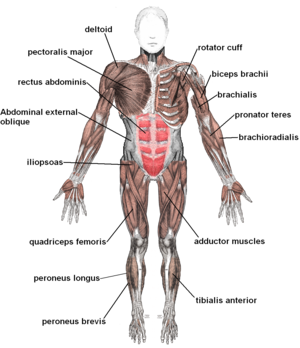| The core muscles include the rectus abdominis, abdominal external obliques, and several muscles in the back and buttocks.(Photo credit: Wikipedia) |
Strengthening Core Muscles
The main responsibility of the core muscles is to provide enough power to the body to enable it to cope with the dynamic challenges of every physical activity that a person encounters.
For this reason, many health and fitness experts have realized that it is relatively more important to strengthen the core muscles than almost any other muscle group in the body. Through various experiments and research, they have found that having a stronger core can lessen a lot of health problems related to posture.
For instance, a well-conditioned core can improve the endurance of the muscles of the back and promote proper spinal alignment, preventing or relieving chronic back pain.
Why? Because muscles that are included in the group of core muscles are actually the ones that initiate the proper stabilization of the whole upper and lower torso.
So, for those who wish to know and understand why it is so important to strengthen the core muscles, here is a list of some of the benefits that you can use as references:
1. Strengthening core muscles will improve posture and prevent low back pain of muscular origin.
This means that as you incorporate stretching exercises in your routine, taking a particular focus on the muscles of the upper and front part of the trunk, and including the abdominal and trunk muscles, the activity has the tendency to strengthen the muscles of the back that extend to the spine.
2. It will help tone the muscles, thereby avoiding further back injury
Exercising your core muscles will strengthen and tones your lower back muscles and buttocks while stretching the hip flexors and the muscles on the front of the thighs.
This can not only help relieve back pain from previous injuries, but it can also help prevent future injury to the lower back.
| (Photo credit: tajai) |
Exercising the core muscles with slow, static stretching is quite effective in relieving stiffness and enhances flexibility. Once the flexibility of a person has improved, it follows that he will be able to perform his physical activities with more ease and comfort.
4. Lengthens muscles and helps improve balance
Core muscle exercises strengthen the center of the body and improve balance and function, two areas which can decline as we age. Building and maintaining a strong core can keep you active and mobile throughout your senior years.
Many health and fitness experts recommend adding core strengthening exercises into your workout routine at least twice a week. Don't think you need to do hundreds of situps either - 10-15 minutes or so spent on the core muscle groups is usually enough. Be sure to choose workouts that work all the various muscles of the core, and not just one or two. Pilates or Yoga are both great forms of exercise which do engage all of your core muscles and promote balance and fitness throughout the body.
Gaining a strong core is important for balance, posture, and avoiding injury, so core exercises are definitely essential to include in your fitness routine.



No comments:
Post a Comment